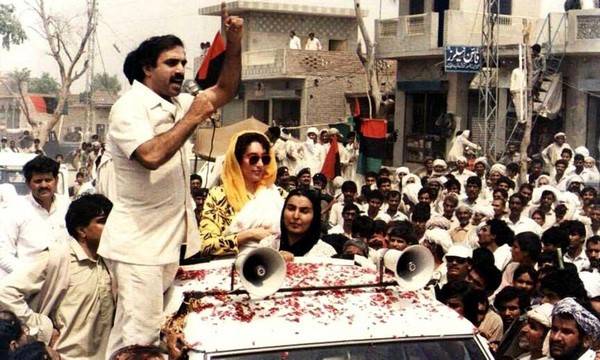
This is a photograph of Benazir Bhutto as she led an election campaign in Lahore in 1988. The 1988 elections were held in November. The Pakistan People’s Party, led by Benazir Bhutto, ousted and disintegrated the technocratic and military government of General Ziaul Haq, with the parliamentary majority of 94 seats. The election was the second of four non-consecutive victories for the PPP and Benazir became Pakistan’s – and the Muslim world’s— first female head of government.
Ms Bhutto had dominated the political landscape since her return to the country in April 1986. One of the military establishment’s main strategies to contain the rise of the PPP was to unite everyone who had anything against the latter under the Islami Jamhoori Ittehad (IJI), an alliance of those who had benefited from the military rule. The main components of the IJI were the Muslim League and the Jamaat-i-Islami (JI). The Muslim League was dominated by the affluent middle class of central Punjab while the JI was its ideologue.
The IJI was not the only challenge the PPP had to face. A number of changes in laws and procedures were introduced into the electoral system to obstruct free and fair character of elections.
Despite the odds, Ms Bhutto triumphed. Her party won 93 seats and polled 38.5 per cent of the vote, becoming the single largest party. Her 7.5 million votes were almost a quarter more than the 6.1 million votes secured by Z.A. Bhutto’s PPP in 1970. More importantly, the party won seats and polled substantial percentages of the votes in Balochistan and what is now Khyber Pakhtunkhwa, where it had no presence earlier. The centre-right and far-right alliance consolidated its vote bank under the banner of IJI. Their 5.9 million votes translated into 54 seats in the National Assembly but, more importantly, the alliance won a majority in Punjab and formed government there.
Ms Bhutto had dominated the political landscape since her return to the country in April 1986. One of the military establishment’s main strategies to contain the rise of the PPP was to unite everyone who had anything against the latter under the Islami Jamhoori Ittehad (IJI), an alliance of those who had benefited from the military rule. The main components of the IJI were the Muslim League and the Jamaat-i-Islami (JI). The Muslim League was dominated by the affluent middle class of central Punjab while the JI was its ideologue.
The IJI was not the only challenge the PPP had to face. A number of changes in laws and procedures were introduced into the electoral system to obstruct free and fair character of elections.
Despite the odds, Ms Bhutto triumphed. Her party won 93 seats and polled 38.5 per cent of the vote, becoming the single largest party. Her 7.5 million votes were almost a quarter more than the 6.1 million votes secured by Z.A. Bhutto’s PPP in 1970. More importantly, the party won seats and polled substantial percentages of the votes in Balochistan and what is now Khyber Pakhtunkhwa, where it had no presence earlier. The centre-right and far-right alliance consolidated its vote bank under the banner of IJI. Their 5.9 million votes translated into 54 seats in the National Assembly but, more importantly, the alliance won a majority in Punjab and formed government there.

